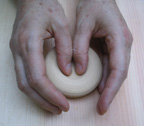Cinda Mefferd
in 2003

I started potting in 1965 at age twelve, continued for twenty years, and returned to clay and teaching the potter's wheel in 2003.
Certified to practice massage therapy in 1985, I noted a quintessential difference between making pots and doing massage. The hands-on work of massage does not produce a solid object to keep and critique.
Furthermore, unlike looking at a bowl to check its quality, a prospective massage client rarely if ever observes a massage therapist's work before receiving it. Therefore, descriptive words: word-of-mouth referrals and phrases that explain technique play a vital role in mastery, especially for beginners. Much will always be done by feel, yet each of us can, for example, imagine and pantomime the varied rhythm patterns of a stone skipping along the surface of water. When this subtle rhythm is incorporated into massage strokes performed on the upper shoulders with one of my thumbs, clients often comment that it feels good.
I began writing about massage therapy in 1996 after a friend, a new graduate of massage school, asked me to tutor her. Before long, she enthusiastically told me that I had a different approach, a real niche, and must teach. Ideas began to flood in. I experimented, practiced, got feedback, planned to open a massage school, and instead turned my attention to writing Poetics of Touch. It features twenty-six concepts that refine the art of massage via Accent, Contrast, Depth and Pace, Imagery, Mechanics, and Safety and Comfort, to name a few. It also includes poems by massage recipients that provide a rare and heartfelt look at the inner journey of massage.
Originally from St. Louis, Missouri, I grew up in an artistic family. We lived in the country near the Missouri River. As a child I spent many hours in nature and loved to fill small vases with flowers, an incentive for making fine porcelain vases later on.
I photographed the flowers on this site and also like to hike, read, cook, garden, and string beads. I have tried most of the artistic crafts.
Please scroll down to see the clay models I made on the potter's wheel as an innovative way to show each stage of making a pot.


